
GENDER-NEUTRAL KNITTING

Nowadays gender-neutral clothing is so commonplace that we barely give our jeans or jumpers a second thought. But like many garments that have entered the world of fashion throughout the years, it wasn’t always so easy to slip between the men and women’s sections. Fair Isle knitting, for one, overcame a complex journey through war and politics to arrive at where it hangs today: in the androgynous department.

Before the Prince of Wales was famously painted sporting a Fair Isle knitted jumper in 1921, Shetland knitwear was very gender-specific. Typically, men wore ‘frokes’ or tank tops while women donned Shetland shawls often made with lace. Once Prince Edward, a notable fashion icon at the time, was portrayed wearing his Fair Isle knitted jumper gifted to him by hosier dealer James A Smith, this design gained a powerful new ambassador.

Meanwhile in this post-war era, women’s fashion was undergoing a seismic shift; from the tight corsets of the 19th century to the loose drapes of 1920s dresses. Women were now freely adopting men’s fashion in the wake of the suffragette movement, and once Fair Isle jumpers became associated with men thanks to the Prince of Wales, Shetland knitting was no exception.

The transition wasn’t easy. The economic effects of World War I meant that during the war, much to their advantage Shetland knitters sold directly to servicemen stationed in the islands. Once it ended, the most skilled knitters were understandably reluctant to return to their local merchants, and this meant that other knitters could afford to increase their prices. Combined with an increase in the cost of wool and the rising availability of cheap, mass-produced clothing, consumers had to pay high prices for Fair Isle designs.

While Shetland garments came with a high price tag, history shows us that it was a worthy price to pay for undoing the sex of knitting. From a traditionally gendered uniform, to high fashion and political weapon, Fair Isle knitting now has a relaxed attitude to men and women’s fashion, but it was built on anything but.
You can take part in a Fair Isle Knitting workshop with designer Marie Wallin at the Selvedge Studio this October. For more information and to book your place, click here.
